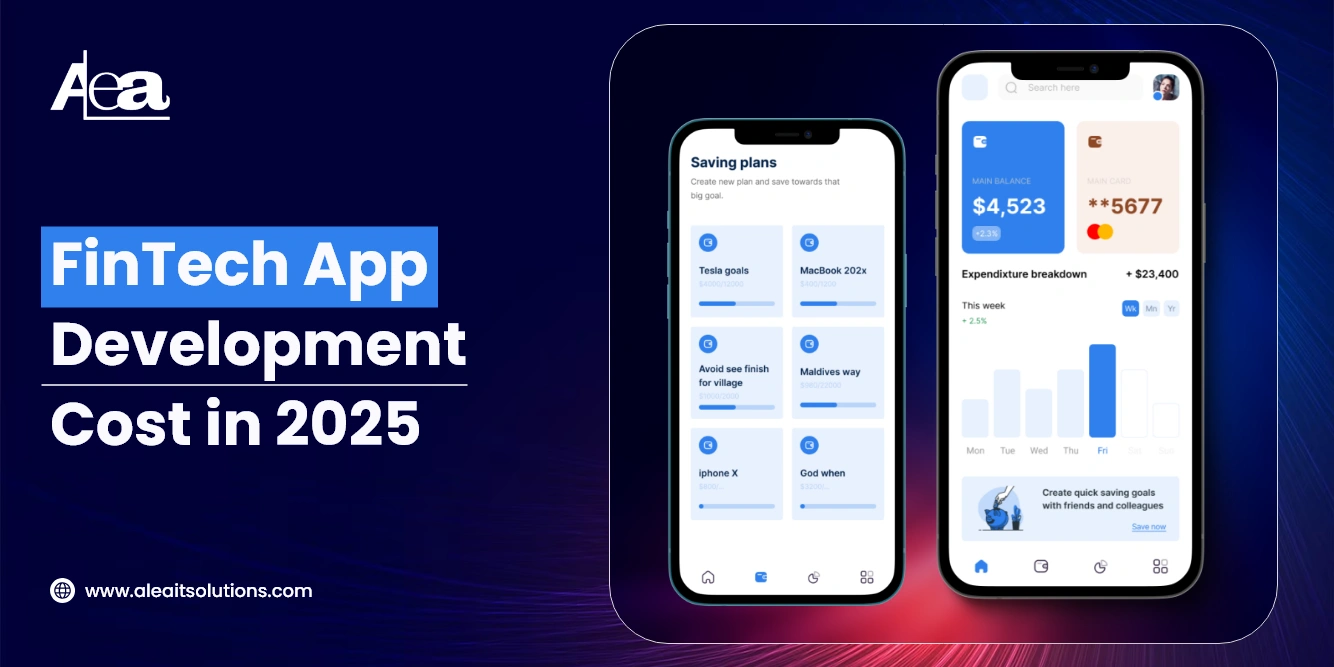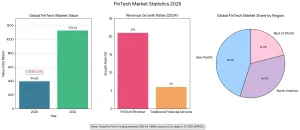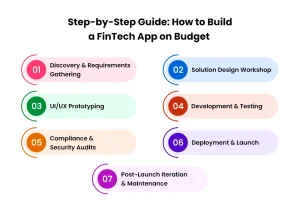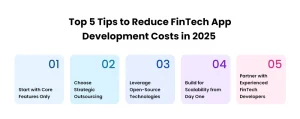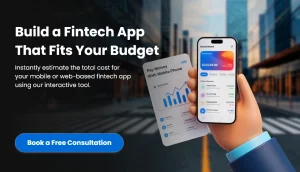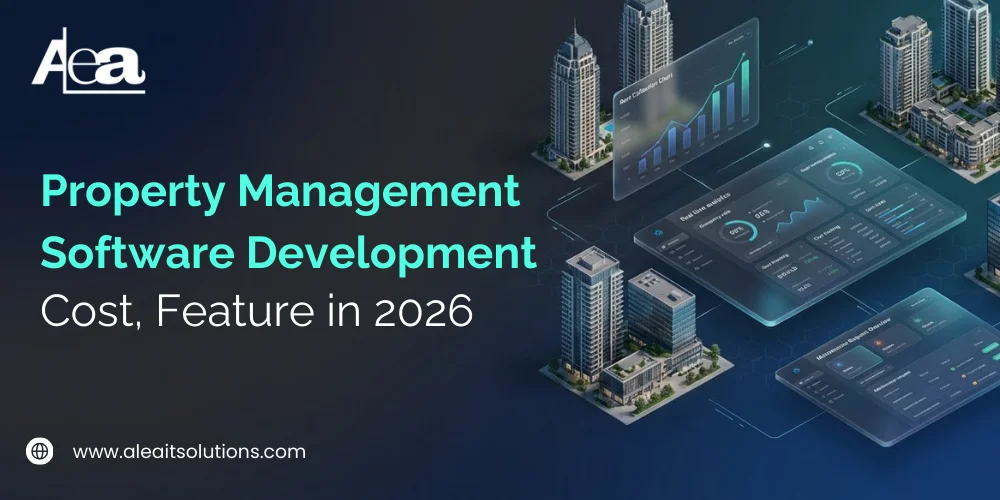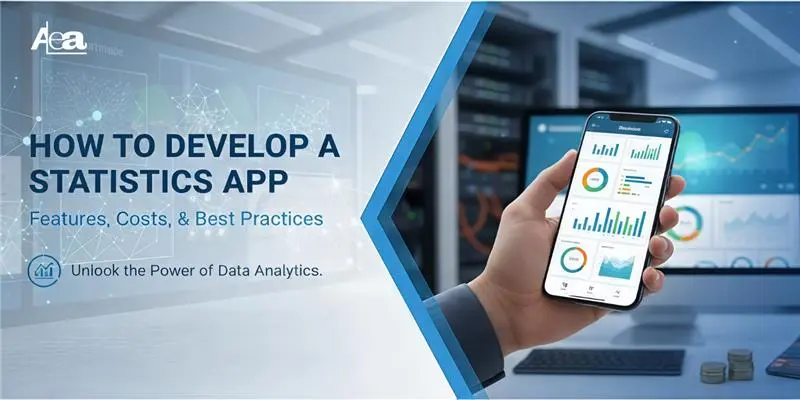The financial technology landscape is evolving at breakneck speed. As we navigate through 2025, understanding fintech app development costs has become more critical than ever for businesses looking to enter this lucrative market.
With digital transformation accelerating across all financial services, from banking to investments, entrepreneurs and established enterprises alike are asking the same question: what does it really cost to build a fintech app?
Similar sectors, including the fantasy sports app market, are also experiencing remarkable expansion, demonstrating how data-driven engagement applications are reshaping user interaction and monetization strategies across industries.
The cost to develop fintech app typically ranges between $20,000 and $300,000+, depending on numerous factors including feature complexity, regulatory compliance requirements, security measures, and your chosen development partner.
This guide will walk you through every aspect of fintech mobile app development pricing, helping you make informed decisions about your investment.
Understanding these costs upfront isn’t just about budgeting it’s about strategic planning. Whether you’re a startup founder validating a new concept or a CTO at an established financial institution, knowing where your money goes and why can make the difference between a successful launch and a costly misstep.
FinTech Market Statistics 2025
- The global fintech market is valued at USD 394.88 billion in 2025 and expected to reach USD 1,126.64 billion by 2032, growing at a CAGR of 16.2% (Fortune Business Insights).
- Fintech revenues grew 21% year-over-year in 2024, surpassing traditional financial services growth of 6%, reflecting the expanding adoption of AI-driven finance and embedded banking solutions (Merchant Savvy).
- According to KPMG’s Pulse of FinTech 2025, global fintech funding reached USD 44.7 billion! across 2,216 deals in the first half of 2025, led by major acquisitions in digital payments and crypto finance (KPMG Pulse of FinTech Report).
- The Asia-Pacific region now accounts for nearly 45% of the global fintech market, outpacing North America’s 34% market share and highlighting the rapid fintech app adoption in India, China, and Southeast Asia (Merchant Savvy).
Read Also: Mobile App Statistics & Trends
What Is the Average Cost to Build a FinTech App in 2025?
When businesses inquire about fintech application development services, the first question is always about price. However, the answer isn’t straightforward because every project has unique requirements, target audiences, and business objectives.
Based on current market analysis and input from leading development companies, here’s what you can expect:
1. Basic MVP Apps:
$20,000 – $50,000 These stripped-down versions focus on core functionality think simple payment processing, basic user authentication, and essential dashboards. They’re perfect for startups looking to validate market demand before scaling.
2. Mid-Level Applications:
$50,000 – $150,000 These applications include more sophisticated features such as advanced analytics, third-party integrations, custom user interfaces, and enhanced security protocols. Most growing fintech companies fall into this category.
3. Complex Enterprise-Grade Platforms:
$150,000 – $300,000+ Full-featured applications with AI-driven insights, blockchain integration, multi-region support, comprehensive compliance frameworks, and real-time fraud detection systems command premium pricing.
This wide cost spectrum exists because the fintech app development cost is influenced by multiple interconnected factors.
A simple digital wallet with peer-to-peer transfers will cost significantly less than a comprehensive banking platform with investment tracking, loan management, and AI-powered financial advisory features.
It’s also worth noting that these figures typically cover the initial development phase. Additional costs for ongoing maintenance, updates, security patches, and feature enhancements should be factored into your long-term budget planning.
Key Factors Driving FinTech App Development Costs
1. App Complexity & Feature Set
The number and sophistication of features you include directly impacts your budget. Here’s a realistic breakdown:
| App Complexity | Features Included | Estimated Hours | Cost Range |
| Simple | Basic transactions, user authentication, account dashboards, profile management | 500–1,200 hours | $20K–$70K |
| Medium | Analytics dashboards, payment gateway integration, KYC/AML compliance, custom UI, card management | 800–2,500 hours | $50K–$130K |
| Complex | AI fraud detection, blockchain integration, multi-currency support, investment portfolios, robo-advisory, real-time trading | 1,500–3,000+ hours | $120K–$300K+ |
2. Security Compliance & Regulatory Requirements
Financial applications operate in one of the most heavily regulated industries. Compliance isn’t optional it’s mandatory.
Your tech stack must support robust security measures and meet strict regulatory standards, which significantly impacts the overall cost.
a. Essential Security Measures:
- Basic authentication and HTTPS encryption: $5,000–$10,000
- Two-factor authentication (2FA): $15,000–$20,000
- Biometric login (Face ID, Touch ID): $20,000–$30,000
- Advanced fraud detection systems: $30,000–$50,000
- Enterprise-grade encryption and compliance modules: $40,000–$60,000
b. Regulatory Frameworks:
Meeting standards like GDPR (General Data Protection Regulation), PCI-DSS (Payment Card Industry Data Security Standard), PSD2 (Payment Services Directive), and regional banking regulations typically increases your budget by 15–30%.
These frameworks require additional development hours for implementing audit trails, secure APIs, data encryption, and comprehensive testing.
Modern fintech application development services prioritize security-first approaches, using multi-layer encryption, secure cloud infrastructure, and continuous monitoring to protect sensitive financial data.
While these measures add to upfront costs, they’re non-negotiable for building user trust and avoiding devastating security breaches.
3. Development Team Location & Platform Choice
Geographic location dramatically affects your development costs. Here’s what you can expect across different regions:
| Region | Hourly Rate (USD) | Notes |
| United States | $100 – $200 | Premium pricing, extensive compliance expertise |
| Western Europe | $80 – $150 | High quality, strong regulatory knowledge |
| Central/Eastern Europe | $40 – $80 | Excellent value, skilled developers, growing fintech expertise |
| India | $20 – $35 | Most cost-effective option, large talent pool |
| Latin America | $25 – $50 | Competitive pricing, favorable time zones for US clients |
Platform Considerations: Your choice between native and cross-platform development significantly impacts both cost and timeline:
- Native Development (iOS and Android separately): Offers maximum performance and security but costs approximately 30–40% more due to maintaining separate codebases.
- Cross-Platform Development (Flutter, React Native): Allows you to maintain one codebase for both platforms, reducing costs by up to 30% and accelerating time-to-market by up to 50%. This approach is particularly beneficial for MVPs and early-stage products.
For most fintech startups and mid-sized companies, partnering with development teams in Central/Eastern Europe or India provides an optimal balance of cost-efficiency and quality.
These regions have matured significantly in recent years, offering experienced fintech app developers who understand both technical requirements and compliance frameworks.
Read Also: Native Apps vs Hybrid Apps
4. UI/UX Design & User Experience
First impressions matter enormously in financial services. Users need to trust your application with their money, and that trust begins with professional, intuitive design.
Design Investment Breakdown:
- Template-based design: $5,000–$10,000
- Custom design with brand-specific elements: $20,000–$40,000
- Advanced design with animations, interactive dashboards, and personalized analytics: $50,000+
Quality UI/UX design typically accounts for 10–15% of your total budget. However, this investment pays dividends: well-designed fintech apps can increase onboarding completion rates by 30–35%, which directly translates to higher customer retention and revenue.
A seamless interface isn’t merely aesthetic it’s functional. Clear navigation, intuitive workflows, and accessible design elements reduce user errors, support tickets, and abandonment rates. In the competitive fintech landscape, superior user experience often becomes your key differentiator.
5. Backend Development & Technology Stack
Backend complexity is where much of your development budget goes. This infrastructure powers everything from transaction processing to data storage and third-party integrations.
Backend Development Costs:
- Simple backend (basic APIs, standard database): $15,000–$25,000
- Medium complexity (advanced integrations, analytics): $30,000–$60,000
- Complex backend (heavy transaction volumes, AI modules, blockchain): $50,000–$100,000+
Technology Stack Considerations: Your chosen technologies impact both immediate costs and long-term scalability:
- Backend Frameworks: Node.js, .NET, Java, Python
- Cloud Infrastructure: AWS, Azure, Google Cloud
- Databases: PostgreSQL, MongoDB, MySQL
- Advanced Features: TensorFlow or PyTorch for AI, Ethereum or Hyperledger for blockchain
Adding cutting-edge technologies like AI-driven fraud detection or blockchain for transaction transparency can increase your development costs by $30,000–$60,000+.
However, these investments often provide competitive advantages that justify the additional expense.
Read Also: The Essential Back-End Languages for Modern Web Development
6. Post-Launch Maintenance & Updates
Many businesses underestimate ongoing costs. Fintech application development doesn’t end at launch it’s a continuous process.
Ongoing Expenses Include:
- Security patches and updates
- Bug fixes and performance optimization
- Feature enhancements and new functionality
- Compliance updates as regulations evolve
- Cloud infrastructure scaling
- Customer support systems
On average, annual maintenance costs run 15–20% of your original development investment. For a $100,000 application, budget approximately $15,000–$20,000 annually for maintenance and updates.
Read More: Web App Development Cost
FinTech App Cost Breakdown by Type: 2025 Estimates
Different types of financial applications require varying levels of complexity, features, and compliance measures.
Here’s a detailed breakdown:
1. Banking Apps
Cost Range: $30,000 – $300,000
Development Time: 4–8 months (2,000–3,500 hours)
Banking applications represent some of the most complex fintech solutions. They require comprehensive features including:
- Account management and balance checking
- Money transfers and bill payments
- Card management and virtual cards
- KYC (Know Your Customer) verification
- Transaction history and analytics
- ATM/branch locators
- Security features and fraud prevention
Real-world examples include Revolut, Chime, and Monobank. The banking app development cost tends toward the higher end because of stringent security requirements, multi-layer compliance frameworks, and the need for real-time fraud detection systems.
2. Lending & BNPL (Buy Now, Pay Later) Apps
Cost Range: $25,000 – $160,000
Development Time: 3–6 months (2,000–2,500 hours)
Peer-to-peer lending and BNPL platforms are experiencing rapid growth. These applications typically include:
- Loan application and approval workflows
- Credit scoring and risk assessment
- Automated repayment scheduling
- KYC verification and document upload
- EMI (Equalized Monthly Instalment) calculators
- Borrower and lender dashboards
Applications like ZestFinance, Dave, and Brigit demonstrate how fintech companies are streamlining traditionally cumbersome lending processes.
Smart systems use artificial intelligence and machine learning to verify credentials, assess borrower history, and predict income projections with remarkable accuracy.
3. Investment & Trading Apps
Cost Range: $35,000 – $250,000
Development Time: 5–9 months (1,500–2,500 hours)
Investment platforms enable users to review and invest in multiple asset classes:
- Real-time market data and price tracking
- Portfolio management and performance analytics
- Trading and order execution
- Investment recommendations and insights
- Cryptocurrency integration
- Robo-advisory features
Examples like Robinhood and Acorns show how investment apps can democratize access to financial markets.
The cost to develop these applications rises when features like AI-driven recommendations, complex trading algorithms, or cryptocurrency modules are added.
This is where expert stock trading app development services come in — helping you balance innovation with cost efficiency.
Related Insights: How to Develop an AI Investing App Like Wealthfront
4. Insurance Apps
Cost Range: $20,000 – $200,000
Development Time: 4–7 months (2,000–3,000 hours)
Insurance technology (InsurTech) applications streamline traditionally paper-heavy processes:
- Policy management and document storage
- Claims submission and tracking
- Premium calculations and quotes
- Payment processing
- Risk assessment tools
- Customer support integration
Applications like GEICO, AIG Travel Assistance, and Root demonstrate how insurance apps can transform user experiences.
The cost varies significantly depending on the type of solution an insurance software development company builds—whether it’s for a specific vertical like health, auto, or travel, or a comprehensive multi-vertical platform.
5. Digital Wallets & Payment Apps
Cost Range: $20,000 – $150,000
Development Time: 3–5 months
Digital wallet applications focus on simplifying transactions:
- Peer-to-peer money transfers
- QR code payments
- Multi-currency support
- Card linking and management
- Transaction history
- Cashback and rewards programs
The digital wallet development cost, tends to be moderate because functionality is relatively straightforward compared to comprehensive banking platforms.
However, when you opt for digital eWallet app development services that include advanced features like cryptocurrency integration, international transfers, or enhanced security layers, the overall cost can increase significantly.
Related Insights:- E-Wallet App Development Cost in 2025
6. Personal Finance Apps
Cost Range: $25,000 – $300,000
Development Time: 2–4 months (1,500–2,500 hours)
Personal finance applications help users take control of their financial lives:
- Budget creation and tracking
- Expense categorization
- Savings goal setting
- Bill reminders and payment scheduling
- Financial insights and recommendations
- Account aggregation across multiple banks
These applications serve as financial journals, helping people monitor earnings, expenses, and progress toward goals.
The cost to build a personal finance app varies based on the sophistication of analytics and whether you include AI-driven personalization.
7. Cryptocurrency & Blockchain Apps
Cost Range: $80,000 – $250,000
Development Time: 6–10 months
Cryptocurrency applications represent the cutting edge of fintech:
- Buying, selling, and storing digital assets
- Blockchain integration
- Decentralized wallet functionality
- Real-time price tracking
- Security protocols and compliance
- Trading features
The higher cost reflects the complexity of blockchain technology, security requirements, and the rapidly evolving regulatory landscape around digital assets.
Read Also: How Much Does an eCommerce App Development Cost in 2025?
MVP vs. Full-Scale FinTech App: Strategic Cost Comparison
One of the most critical decisions you’ll make is whether to build an MVP or immediately develop a full-featured application.
1. MVP (Minimum Viable Product)
Cost Range: $20,000–$50,000
Timeline: 3–4 months
Purpose: Test market fit, validate assumptions, attract initial users and investors
An MVP includes only core features necessary to solve your users’ primary pain point. This lean approach allows you to:
- Enter the market quickly
- Gather real user feedback
- Iterate based on actual usage data
- Secure funding with a working product
- Reduce financial risk
2. Mid-Scale Application
Cost Range: $50,000–$150,000
Timeline: 5–7 months
Purpose: Expand user base, add competitive features, improve retention
Once your MVP proves successful, you can expand with additional features, enhanced security, better analytics, and more sophisticated user experiences.
4. Enterprise-Grade Platform
Cost Range: $150,000–$300,000+
Timeline: 8–12+ months
Purpose: Scale to millions of users, dominate market segment, ensure enterprise-level security
Full-scale applications include comprehensive features, advanced technologies (AI, blockchain), multi-region support, and enterprise-grade infrastructure capable of handling massive transaction volumes.
Strategic Recommendation: Over 70% of successful fintech startups begin with MVPs. This approach minimizes risk, validates product-market fit, and provides the data you need to make informed decisions about scaling.
Hidden Costs in FinTech App Development (And How to Avoid Them)
Many businesses are surprised by expenses that weren’t in their original budget. Here are the most common hidden costs:
1. Compliance Audits & Certifications
Cost: $10,000–$50,000+
Financial regulations require formal audits and certifications. PCI-DSS compliance alone can cost $10,000–$20,000 annually.
Add GDPR, PSD2, and regional banking requirements, and these costs multiply. Factor these in from day one rather than treating them as afterthoughts.
2. Third-Party API Licenses & Integration
Cost: $5,000–$30,000 annually
Payment gateways, KYC verification services, credit score checks, fraud detection systems, and banking APIs typically charge monthly or per-transaction fees.
These recurring costs can significantly impact your operating budget.
3. Cloud Infrastructure & Scaling
Cost: Starting at $500/month, scaling to $5,000+ as you grow
Cloud hosting on AWS, Azure, or Google Cloud isn’t a one-time expense. As your user base grows and transaction volumes increase, your infrastructure costs scale proportionally. Proper planning for this growth prevents budget surprises.
4. Security Updates & Monitoring
Cost: $3,000–$10,000+ annually
Continuous security monitoring, vulnerability assessments, penetration testing, and security patch deployment are ongoing necessities. Financial applications are prime targets for cybercriminals, making robust security non-negotiable.
5. Legal & Regulatory Consulting
Cost: $5,000–$25,000+
Navigating financial regulations often requires specialized legal expertise. Regulatory consultants who understand fintech compliance frameworks can prevent costly mistakes and ensure you launch legally.
6. User Acquisition & Marketing
Cost: Highly variable
Building your app is only half the battle. Customer acquisition costs in fintech are typically higher than in other industries due to trust barriers. Budget appropriately for marketing, user onboarding incentives, and growth campaigns.
Pro Tip: Build a financial buffer of 20–30% above your estimated development costs to account for these hidden expenses and inevitable scope adjustments.
Step-by-Step Guide: How to Build a FinTech App on Budget
Building a successful fintech application requires methodical planning and execution. Here’s a proven process:
Step 1: Discovery & Requirements Gathering
Timeline: 1–3 weeks
Cost: $5,000–$15,000
Begin by clearly defining your value proposition, target market, core features, and compliance requirements. Work with business analysts to document:
- User personas and pain points
- Competitive landscape
- Regulatory frameworks applicable to your solution
- Success metrics and KPIs
This foundation prevents costly rework later by ensuring everyone shares a clear vision.
Step 2: Solution Design Workshop
Timeline: 1–2 weeks
Cost: $5,000–$10,000 (often free with development commitment)
Solution architects and business analysts collaborate with your team to:
- Define technical architecture
- Identify integration requirements
- Assess compliance needs
- Create preliminary timelines and cost estimates
This stage bridges business requirements and technical implementation, ensuring feasibility.
Step 3: UI/UX Prototyping
Timeline: 3–5 weeks
Cost: $10,000–$40,000
Designers create wireframes, user journey maps, and interactive prototypes. This stage includes:
- Information architecture
- User flow diagrams
- Visual design mockups
- Usability testing with target users
Quality design reduces development costs by catching usability issues before coding begins.
Step 4: Development & Testing
Timeline: 4–8 months
Cost: $50,000–$200,000+
This is the core phase where developers build frontend interfaces, backend systems, and integrate third-party services. Simultaneously, QA engineers conduct:
- Functional testing
- Security testing
- Performance testing
- Compliance verification
- User acceptance testing
Testing activities typically run parallel to development, adding 15–20% to development costs but ensuring a stable, secure product at launch.
Step 5: Compliance & Security Audits
Timeline: 2–4 weeks
Cost: $10,000–$30,000
Before launch, conduct formal security audits and compliance certifications. This includes:
- Penetration testing
- Code security reviews
- Compliance documentation
- Obtaining necessary certifications
This step is crucial for avoiding regulatory penalties and building user trust.
Step 6: Deployment & Launch
Timeline: 1–2 weeks
Cost: $5,000–$10,000
Deploy your application to production environments, including:
- App store submissions (iOS and Android)
- Cloud infrastructure setup
- Monitoring systems configuration
- Launch marketing coordination
Step 7: Post-Launch Iteration & Maintenance
Timeline: Ongoing
Cost: $5,000–$20,000+ monthly
After launch, continuously improve your application based on:
- User feedback and analytics
- Performance monitoring
- Security updates
- Feature enhancements
- Regulatory changes
This structured approach minimizes risk, controls costs, and ensures you build fintech app that meets both user needs and regulatory requirements.
Top 5 Tips to Reduce FinTech App Development Costs in 2025
1. Start with Core Features Only
Focus on solving one primary user problem exceptionally well rather than building a feature-bloated application. You can always add functionality later based on user demand.
2. Choose Strategic Outsourcing
Partnering with development teams in cost-effective regions like India, Eastern Europe, or Latin America can reduce your development costs by 30–50% without sacrificing quality.
3. Leverage Open-Source Technologies
Use proven open-source frameworks, libraries, and tools rather than building everything from scratch. This approach significantly reduces development time and costs.
4. Build for Scalability from Day One
Investing in proper architecture initially costs more but saves enormously later. Poorly architected applications require expensive rebuilds when scaling.
5. Partner with Experienced FinTech Developers
Working with fintech app development company specialists who understand financial regulations, security requirements, and industry best practices prevents costly mistakes and accelerates time-to-market.
Monetization Strategies for Your FinTech App
Understanding how your application will generate revenue is crucial for ROI planning. Successful fintech applications typically employ multiple revenue streams:
1. Subscription Models
How It Works: Users pay recurring fees (monthly/annually) for premium features, advanced analytics, or enhanced services.
Best For: Personal finance apps, investment platforms, business banking solutions
Revenue Potential: $5–$50 per user monthly, depending on value proposition
2. Transaction Fees
How It Works: Charge a small percentage or flat fee per transaction processed through your platform.
Best For: Payment processors, money transfer apps, trading platforms
Revenue Potential: 0.5–3% per transaction or $0.25–$2 flat fees
3. Interchange Fees
How It Works: Earn a portion of the merchant processing fee when users make purchases with cards linked to your app.
Best For: Digital wallets, challenger banks, payment apps
Revenue Potential: Passive income stream, typically 1–2% of transaction value
4. Interest & Lending Revenue
How It Works: Generate income from interest on loans, credit lines, or BNPL services offered through your platform.
Best For: Lending apps, BNPL services, challenger banks
Revenue Potential: 5–20% APR depending on product type and risk profile
5. Freemium Models
How It Works: Offer basic features free while charging for premium functionality, higher limits, or advanced tools.
Best For: Nearly all fintech verticals
Revenue Potential: 2–5% conversion rates from free to paid tiers
6. Affiliate Partnerships
How It Works: Earn commissions by recommending financial products like credit cards, loans, or insurance policies.
Best For: Personal finance apps, comparison platforms, financial advisory apps
Revenue Potential: $50–$500 per successful referral
Strategic Insight: The most successful fintech applications combine multiple monetization strategies. For example, a digital banking app might use subscriptions for premium accounts, transaction fees for certain transfers, and affiliate revenue from credit card offers.
This diversification creates resilient revenue streams and can achieve 40–60% annual ROI when implemented strategically.
Why Choose AleaIT Solutions for FinTech App Development
At AleaIT Solutions, we’re more than just a fintech app development company we’re your strategic innovation partner. With over 50+ successful FinTech projects delivered globally, we understand the unique challenges and opportunities in financial technology.
Our Expertise:
- End-to-End fintech application development services from concept validation to post-launch optimization
- Proven track record helping startups and enterprises achieve up to 40% cost savings through smart architecture and agile methodologies
- Regulatory compliance specialists with deep knowledge of GDPR, PCI-DSS, PSD2, and regional banking regulations
- Security-first approach implementing enterprise-grade encryption, fraud detection, and continuous monitoring
- Cutting-edge technology integration including AI, blockchain, and advanced analytics
What Sets Us Apart:
Our fintech app developers bring both technical excellence and financial domain expertise. We don’t just write code we architect solutions that scale, comply with regulations, and deliver exceptional user experiences.
Whether you’re launching an MVP to test market demand or building an enterprise-grade platform to serve millions of users, we provide the expertise, technology, and support to bring your vision to life.
Frequently Asked Questions: FinTech App Development Cost 2025
Q1: How much does a basic FinTech app cost?
A: A basic MVP typically costs $20,000–$50,000, depending on core features, platform choice (iOS, Android, or both), and security requirements. This budget covers essential functionality like user authentication, basic transactions, and simple dashboards.
Q2: What’s the ROI timeline for FinTech investments?
A: Most fintech startups begin seeing return on investment within 12–18 months post-launch, though this varies significantly based on user acquisition costs, monetization strategy, and market conditions. Well-executed MVPs with strong product-market fit can achieve profitability faster.
Q3: Can AI reduce development costs?
A: While AI integration initially increases development costs by $30,000–$60,000, it can reduce long-term operational expenses through automation.
AI-powered fraud detection, customer service chatbots, and predictive analytics minimize manual workload and improve efficiency over time.
Q4: How long does it take to build a custom FinTech MVP?
A: A feature-complete MVP typically requires 3–6 months, including discovery, design, development, testing, and deployment. Complex applications with advanced compliance requirements may take 8–12 months.
Q5: What are the best regions for affordable FinTech outsourcing?
A: India offers the most cost-effective rates ($20–$35/hour) with a large talent pool, while Central and Eastern Europe ($40–$80/hour) provides an excellent balance of cost-efficiency, quality, and convenient time zones for European and US clients.
Q6: Is it better to build native or cross-platform fintech apps?
A: For MVPs and early-stage products, cross-platform frameworks like Flutter or React Native reduce costs by 30% and accelerate time-to-market by 50%. For enterprise applications where maximum performance and security are critical, native development may be worth the additional investment.
Q8: How much should I budget for post-launch maintenance?
A: Plan for 15–20% of your original development cost annually. For a $100,000 application, budget $15,000–$20,000 per year for updates, security patches, feature enhancements, and infrastructure scaling.

